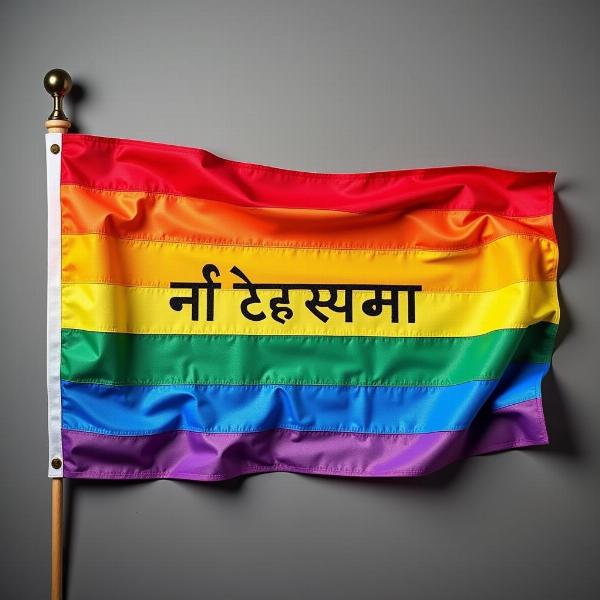Understanding the meaning of “gay” in Hindi requires navigating cultural nuances and evolving language. While a direct, universally accepted equivalent doesn’t exist, several terms convey similar meanings, each with its own connotations. This article explores the various ways “gay” is interpreted and used in the Hindi language, examining both formal and colloquial expressions.
Exploring the Term “Gay” in the Hindi Context
“Gay” primarily refers to homosexuality, specifically male homosexuality. However, its usage in Hindi isn’t as straightforward as in English. Directly translating “gay” often leads to misinterpretations or confusion. The term itself is relatively recent in Hindi, influenced by Western culture. Traditionally, Indian society used more subtle or euphemistic language to discuss sexuality.
Traditional and Contemporary Terms for “Gay” in Hindi
Historically, terms like “napunsak” (नपुंसक) or “hijra” (हिजड़ा) were sometimes used, but these carry different connotations and are not accurate representations of “gay.” “Napunsak” refers to impotence or asexuality, while “hijra” refers to a distinct gender identity within South Asian culture. Neither term accurately captures the meaning of homosexual attraction or identity.
More contemporary and accurate translations include “samalingi” (समलिंगी), which literally means “same-sex attracted.” This term is increasingly accepted in formal contexts like legal and medical discussions. “Samalingi kamukta” (समलिंगी कामुकता) refers to homosexuality as a sexual orientation.
Colloquially, terms like “gay” itself are becoming more common, especially among younger generations. However, these terms can sometimes be used derogatorily or with a lack of understanding.
Understanding the Cultural Nuances
The understanding and acceptance of homosexuality vary significantly across India. While legal changes have been made, social attitudes are still evolving. In some communities, open discussions about sexuality remain taboo. This makes finding accurate and respectful translations even more important.
Sensitivity and Respect in Language
When discussing this topic in Hindi, sensitivity and respect are paramount. Using outdated or derogatory terms can be hurtful and inaccurate. Choosing terms like “samalingi” demonstrates a greater understanding and respect for the LGBTQ+ community.
 Using Respectful Language When Talking About the LGBTQ+ Community
Using Respectful Language When Talking About the LGBTQ+ Community
Common Questions About “Gay” in Hindi
What are the legal implications of being gay in India? While homosexuality is no longer criminalized, same-sex marriage is not yet legally recognized. Legal rights and protections for LGBTQ+ individuals are still developing.
How is the LGBTQ+ community represented in Hindi media? Representation is increasing, but often faces censorship or social backlash. There’s a growing movement for more authentic and inclusive portrayals in films, television, and literature.
Conclusion: Navigating the Meaning of “Gay” in Hindi
Understanding the meaning of “gay” in Hindi requires understanding the cultural context and the evolving language surrounding sexuality. While direct translations may not always capture the nuances, using respectful and accurate terms like “samalingi” is crucial for sensitive and informed communication. As society progresses, the language will continue to evolve, reflecting a more inclusive and understanding approach to LGBTQ+ identities.
FAQ:
- What’s the most respectful way to say “gay” in Hindi? “Samalingi” (समलिंगी) is generally considered the most respectful and accurate term.
- Is “hijra” a synonym for “gay”? No, “hijra” refers to a distinct gender identity in South Asian culture and should not be used interchangeably with “gay.”
- Is it acceptable to use the English word “gay” in Hindi conversations? While becoming more common, especially among younger generations, it’s best to use “samalingi” for clarity and respect.
- Are there other terms related to homosexuality in Hindi? Yes, “samalingi kamukta” (समलिंगी कामुकता) refers to homosexuality as a sexual orientation.
- Where can I find more information about LGBTQ+ resources in India? Several organizations offer support and information, including The Humsafar Trust and Nazariya.
- What is the legal status of homosexuality in India? Homosexuality is not illegal, but same-sex marriage is not currently recognized.
- How can I be an ally to the LGBTQ+ community in India? Educate yourself on LGBTQ+ issues, use respectful language, and support organizations working for equality.
Meaning-Hindi.in specializes in accurate and culturally sensitive translations between Hindi and various other languages. We offer a wide range of translation services, including business and legal document translation, technical translation, website localization, and more. Our expert linguists ensure that your message is conveyed with precision and respect, bridging cultural gaps and fostering effective communication. Contact us today for all your Hindi translation needs at [email protected] or call us at +91 11-4502-7584. Meaning-Hindi.in is your trusted partner for professional Hindi translation services.